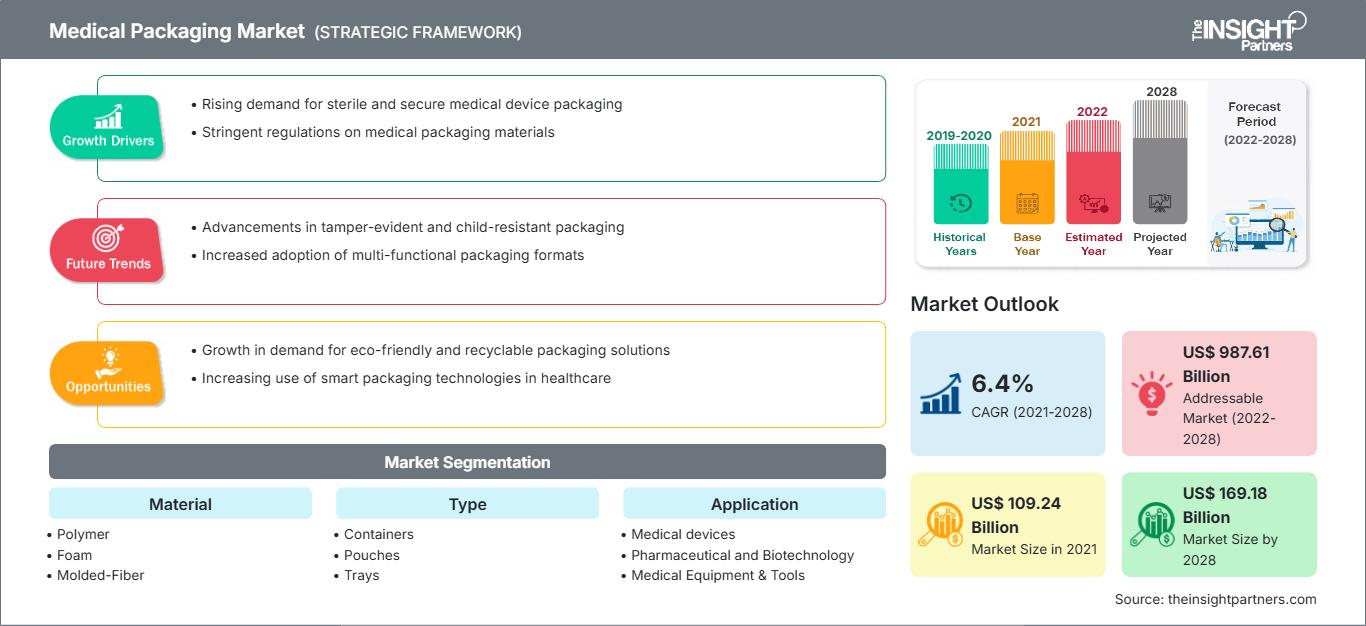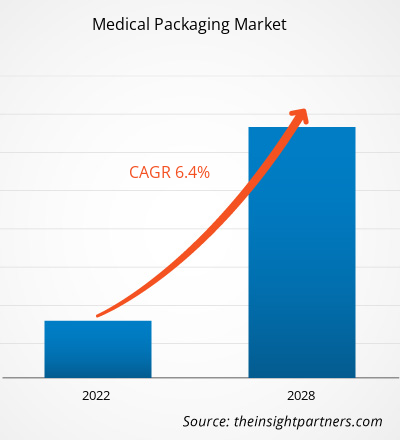Se proyecta que el mercado de envases médicos alcance los US$ 169.183,91 millones para 2028 desde los US$ 109.238,35 millones en 2021; se espera que crezca a una CAGR del 6,4% entre 2021 y 2028.
El embalaje médico es esencial para mantener la calidad del producto y promover un uso seguro y eficaz. El embalaje se realiza para garantizar la seguridad de los productos médicos durante su almacenamiento, distribución, venta y uso. El material utilizado para el embalaje es un sistema de barrera estéril que protege los medicamentos, equipos y otros productos médicos. Además, el embalaje médico requiere un alto nivel de esterilidad para garantizar que el producto esté libre de contaminación. Estos sistemas de embalaje médico aumentan la seguridad del paciente y mejoran el rendimiento del embalaje. Factores como la mayor importancia a la comodidad y las cuestiones ambientales, así como la creciente demanda de mecanismos para prevenir la falsificación, impulsan el mercado del embalaje médico. Sin embargo, se espera que las fluctuaciones en los precios de las materias primas limiten en cierta medida el crecimiento del mercado durante el período de pronóstico.
Obtendrá personalización en cualquier informe, sin cargo, incluidas partes de este informe o análisis a nivel de país, paquete de datos de Excel, así como también grandes ofertas y descuentos para empresas emergentes y universidades.
Mercado de envases médicos: perspectivas estratégicas

-
Obtenga las principales tendencias clave del mercado de este informe.Esta muestra GRATUITA incluirá análisis de datos, desde tendencias del mercado hasta estimaciones y pronósticos.
Perspectivas del mercado
Aumento de la demanda de mecanismos de prevención de falsificaciones
Se han detectado productos médicos falsificados en la mayoría de los Estados miembros y en todas las regiones. Algunos ejemplos incluyen medicamentos de uso generalizado como la atorvastatina o el paracetamol; medicamentos de uso limitado como la hormona del crecimiento, el paclitaxel y el filgastrim; y otros tipos de fármacos como el sildenafilo y el tadalafilo, así como dispositivos médicos como lentes de contacto, preservativos, mallas quirúrgicas y tiras reactivas utilizadas por pacientes diabéticos para controlar sus concentraciones de glucosa en sangre. La falsificación ha afectado tanto a productos caros como a productos baratos, así como a productos genéricos y de marca. Los productos falsificados aparecen en farmacias comunitarias, hospitales y otros entornos con menor regulación.
A menudo se asume que los países de altos ingresos con sistemas regulatorios sólidos pueden excluir eficazmente los productos médicos de baja calidad y falsificados de sus mercados. Sin embargo, el análisis de la Organización Mundial de la Salud (OMS) muestra que esto no es necesariamente así, ya que países de Europa Occidental y América del Norte, así como otros entornos de altos ingresos, han presentado informes sobre estos productos. Por ejemplo, una encuesta reciente en el Reino Unido, realizada por Sapio Research y encargada por la empresa privada INCOPRO, concluye que casi un tercio (32%) de quienes han comprado uno o más medicamentos falsificados han sufrido un problema de salud como resultado (INCOPRO, 2020). Numerosos otros casos documentados en los que pacientes han fallecido o sufrido daños debido a una compra en línea. Por ejemplo, en 2013, varias personas murieron después de tomar una píldora dietética falsificada comprada a través de un vendedor de medicamentos en línea. La píldora, vendida como ayuda para bajar de peso a través de muchas farmacias en línea ilegales, era en realidad un pesticida con consecuencias letales para los humanos.
La amenaza que representan los medicamentos falsificados para el sector farmacéutico global es inmensa. Desde formulaciones falsas hasta problemas en el proceso de fabricación, algunas cifras del sector estiman que podríamos estar ante pérdidas de ingresos de hasta 27 000 millones de euros solo en Europa. La Asociación Internacional de Fabricantes de Hologramas (IHMA) es una importante fuente de conocimientos especializados en este campo y destaca un informe del sector que indica un crecimiento continuo de las tecnologías de envasado antifalsificación. Según la IHMA, el informe "Tecnologías de Antifalsificación, Autenticación y Verificación" destaca la mayor experiencia que la holografía aporta a la autenticación de productos de envasado. La innovación tecnológica en las tecnologías de antifalsificación, autenticación y verificación es un factor importante que contribuye al crecimiento del mercado.
La creciente demanda de técnicas anti-falsificación para proteger los intereses de los pacientes ha fortalecido aún más el crecimiento del sector de los envases médicos.
Perspectivas basadas en tipos
Según el tipo, el mercado de envases médicos se clasifica en contenedores, bolsas, bandejas, blísteres, viales y otros. En 2021, el segmento de contenedores tuvo la mayor participación de mercado por tipo. Se estima que el segmento de blísteres crecerá a una tasa de crecimiento anual compuesta (TCAC) significativa durante el período de pronóstico debido al aumento del desarrollo y lanzamiento de productos.
Perspectivas basadas en materiales
Según el material, el mercado de envases médicos se ha segmentado en polímeros, espumas, fibras moldeadas, telas no tejidas, películas, papel y cartón, entre otros. En 2021, el segmento de polímeros tuvo la mayor participación de mercado por material. Además, se espera que este segmento crezca al ritmo más rápido en los próximos años.
Perspectivas basadas en aplicaciones
Según la aplicación, el mercado de envases médicos se ha segmentado en dispositivos médicos, productos farmacéuticos y biotecnológicos, equipos y herramientas médicos, entre otros. En 2021, el segmento farmacéutico y biotecnológico tuvo la mayor participación de mercado. Se estima que este segmento crecerá a una tasa de crecimiento anual compuesta (TCAC) significativa durante el período de pronóstico debido al aumento de la producción de productos farmacéuticos y biotecnológicos en los mercados globales debido a la creciente prevalencia de enfermedades crónicas.
Varias empresas que operan en el mercado de envases médicos están adoptando estrategias como lanzamientos de productos, fusiones y adquisiciones, colaboraciones, innovaciones de productos y expansiones de carteras de productos para expandir su presencia en todo el mundo, mantener la marca y satisfacer la creciente demanda de los usuarios finales.
Perspectivas regionales del mercado de envases médicos
Los analistas de The Insight Partners han explicado detalladamente las tendencias regionales y los factores que influyen en el mercado de envases médicos durante el período de pronóstico. Esta sección también analiza los segmentos y la geografía del mercado de envases médicos en América del Norte, Europa, Asia Pacífico, Oriente Medio y África, y América del Sur y Central.
Alcance del informe de mercado de envases médicos
| Atributo del informe | Detalles |
|---|---|
| Tamaño del mercado en 2021 | US$ 109.24 mil millones |
| Tamaño del mercado en 2028 | US$ 169.18 mil millones |
| CAGR global (2021-2028) | 6,4% |
| Datos históricos | 2019-2020 |
| Período de pronóstico | 2022-2028 |
| Segmentos cubiertos |
Por material
|
| Regiones y países cubiertos |
América del norte
|
| Líderes del mercado y perfiles de empresas clave |
|
Densidad de actores del mercado de envases médicos: comprensión de su impacto en la dinámica empresarial
El mercado de envases médicos está creciendo rápidamente, impulsado por la creciente demanda del usuario final debido a factores como la evolución de las preferencias de los consumidores, los avances tecnológicos y un mayor conocimiento de los beneficios del producto. A medida que aumenta la demanda, las empresas amplían su oferta, innovan para satisfacer las necesidades de los consumidores y aprovechan las tendencias emergentes, lo que impulsa aún más el crecimiento del mercado.

- Obtenga una descripción general de los principales actores clave del mercado de envases médicos
Mercado de envases médicos por tipo
- Contenedores
- Bolsas
- Bandejas
- Paquetes blíster
- Viales
- Otros
Mercado de envases médicos: por material
- Polímero
- Espuma
- Fibra moldeada
- Tela no tejida
- Películas
- Papel y cartón
- Otros
Mercado de envases médicos: por aplicación
- Dispositivos médicos
- Farmacéutica y Biotecnología
- Equipos y herramientas médicas
- Otros
Mercado de envases médicos por geografía
-
América del norte
- A NOSOTROS
- Canadá
- México
-
Europa
- Francia
- Alemania
- Italia
- Reino Unido
- España
- Resto de Europa
-
Asia Pacífico (APAC)
- Porcelana
- India
- Corea del Sur
- Japón
- Australia
- Resto de Asia Pacífico
-
Oriente Medio y África (MEA)
- Sudáfrica
- Arabia Saudita
- Emiratos Árabes Unidos
- Resto de Oriente Medio y África
-
América del Sur (SAM)
- Brasil
- Argentina
- Resto de América del Sur y Central
Perfiles de empresas
- Amcor plc
- DuPont de Nemours, Inc.
- Corporación química Mitsubishi
- SGD Pharma
- 3M
- Servicios farmacéuticos del oeste, Inc.
- Corporación Avery Dennison
- Compañía de productos Sonoco
- Industrias CCL Inc.
- Compañía WestRock
- Análisis histórico (2 años), año base, pronóstico (7 años) con CAGR
- Análisis PEST y FODA
- Tamaño del mercado, valor/volumen: global, regional y nacional
- Industria y panorama competitivo
- Conjunto de datos de Excel
Informes recientes
Informes relacionados
Testimonios
Razón para comprar
- Toma de decisiones informada
- Comprensión de la dinámica del mercado
- Análisis competitivo
- Información sobre clientes
- Pronósticos del mercado
- Mitigación de riesgos
- Planificación estratégica
- Justificación de la inversión
- Identificación de mercados emergentes
- Mejora de las estrategias de marketing
- Impulso de la eficiencia operativa
- Alineación con las tendencias regulatorias






















 Obtenga una muestra gratuita para - Mercado de envases médicos
Obtenga una muestra gratuita para - Mercado de envases médicos